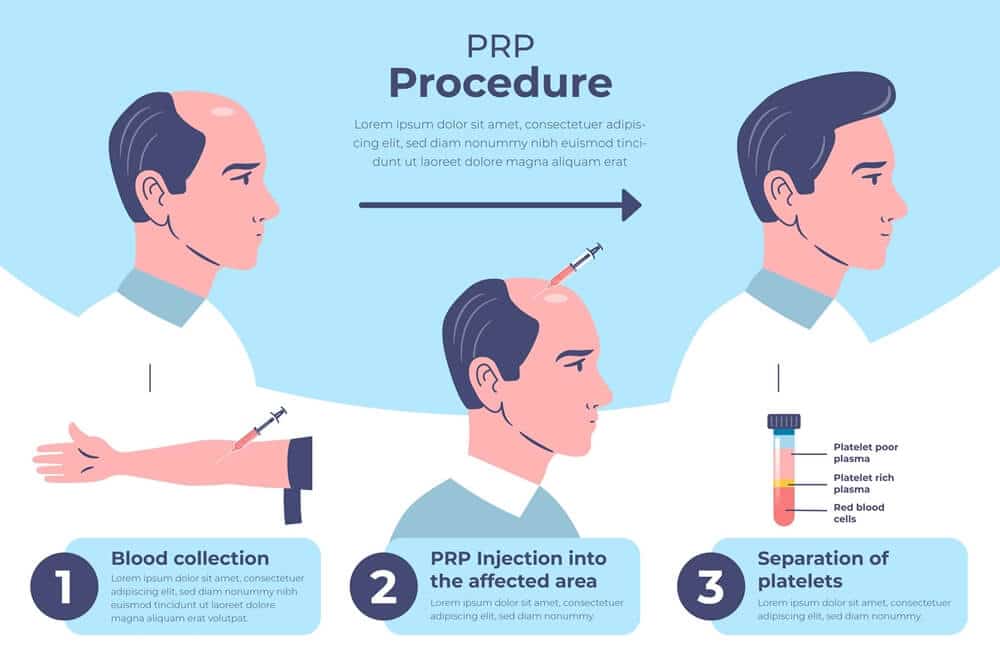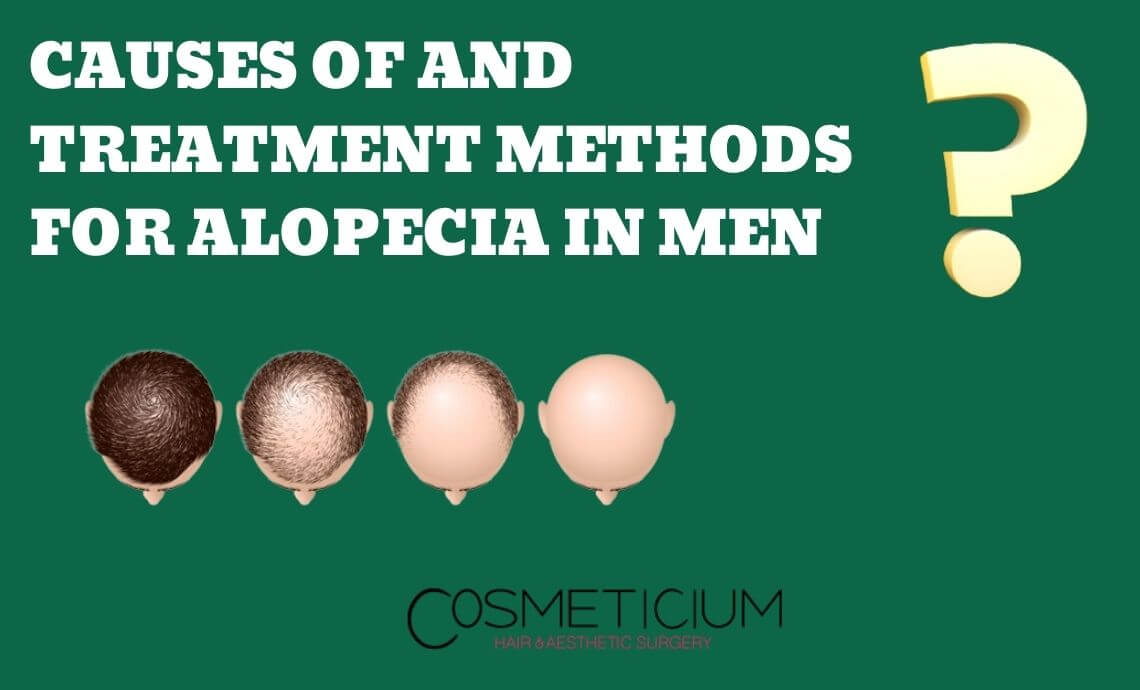There are different causes of hair loss in men. Androgenetic alopecia is one of them. People who are genetically predisposed to this type of hair loss may lose their hair depending on the androgen level. For hair loss, androgen level does not even need to be very high. Sometimes even normal levels of androgen can trigger hair loss. We have compiled the main causes of alopecia in men, its incidence, treatment methods and all the details for you.
Table of Contents
5 Primary Causes of Alopecia in Men
Knowing the causes of hair loss is the first step towards the right treatment. Therefore, when you feel a significant shedding in your hair, you should directly consult a dermatologist. Thus, you can determine exactly why your hair sheds and you can start the right treatment.
Alopecia can occur due to different reasons. Correctly identifying the cause of its occurrence will be the main determining factor in the treatment to be followed.
1. Telogen Effluvium
Telogen effluvium usually occurs suddenly and stress or similar external factors lie at the bottom of this. In this disease, hair initially becomes thinner. However, after a while, hair follicles pass into telogen phase, or resting phase, earlier than it should be and hair loss occurs.
One of the most important causes of this disease is stress. Loss of a loved one, pangs of love, or stressing due to a different reason can trigger telogen effluvium. When stress factor disappears, hair starts to grow again.
Apart from stress, different external factors can also cause this problem. One of these factors is wearing hat and similar clothes too much onto head to protect it from cold during spring time and then exposure of scalp to heat. Again, excessive exposure to the sun in early autumn is among the factors that accelerate telogen phase.
2. Genetics
Genetics is the most noticeable cause of alopecia in men. People who have the same genetic characteristics are more likely to have alopecia. The main ones are alopecia areata and androgenetic alopecia.
Alopecia areata is a condition in which coin-sized bald areas form on scalp. Although it usually occurs on scalp, it can also be seen in different parts of the body.

Source: articleritz.com
Androgenetic alopecia is related to an activated version of testosterone known as DHT. Due to genetic predisposition, DHT attacks hair follicles and causes hair loss. This situation can cause permanent baldness.
Read Also: Which Genes Trigger Hair Loss?
3. Lifestyle
Lifestyle is among the causes of alopecia in men. Adopting a sedentary lifestyle and, in addition, an unhealthy diet will affect the health of whole body. In such a case, it is inevitable that hair health will be affected.
4. Hormonal Changes
Although hormonal changes are more common in women due to menstrual cycle, they can also be seen in men due to different reasons. Androgenetic alopecia can be seen in the last stages of adolescence with decrease in testosterone level and active DHT hormone.
5. Drugs Used
Alopecia may occur due to side effects of drugs used or medical treatments applied. In such cases, the problem is usually temporary. When drug use is stopped, hair largely restores its former state. However, it should be noted that there are exceptions to this.

Prevalence of Alopecia in Men
Incidence of alopecia in men can vary depending on different factors, especially genetics. According to researches made:
- Approximately 96% of white-race men are affected by this disorder at certain rates.
- Black race is less affected than the white race.
- The rate of alopecia in Far Eastern races is quite low.
The variable of age is an important factor over incidence. For every 10 years of age, the probability of alopecia increases by approximately 10%. For example, while alopecia rate is 30% among people who are in their 30s, it is around 50% among people who are in their 50s.
Clinical Symptoms of Alopecia in Men
Alopecia in men can begin at different ages. The most common age range is between 20 and 40. In spite of that, it can sometimes start at the end of adolescence, at the age of 15-17 years.
Androgenetic alopecia begins as hair pulling back on the temples. After that, it continues with hair thinning in vertex area. In severe cases, baldness occurs in vertex region, and this baldness is combined with the retraction that occurs in anterior regions. In such a case, only hair remains on sides and nape areas. Other areas become completely bald. Shedding in vertex area may be more distinct sometimes.

In some people, baldness occurs after a 5-year period. In some people, this process can take 15-20 years. While an average of 5% hair loss occurs each year, this loss may be faster in some periods and slower in other periods.
Read Also: Do You Have Too Much Hair Loss In the Shower?
4 Effective Treatment Methods for Androgenic Alopecia
Alopecia in men is one of the most common hair loss types today. Recognizing this problem early and determining the causes correctly have great importance in the respective treatment process. 4 effective treatment methods for androgenetic alopecia in men and their explanations are as follows:
1. Finasteride
Finasteride works by preventing testosterone hormone from transforming into DHT. The drug has no effect on androgen receptors. It also does not cause decrease in testosterone level. Therefore, it does not have an androgenetic effect and men can use it with peace of mind.
Approved by the FDA in 1997, this drug must be used for at least 1 year in order to see its effectiveness. It has no interaction with other drugs. Side effects are rarely seen. Decrease in ejaculate volume (0.8%), decrease in libido (1.8%) and erectile dysfunction (1.3%) are important side effects.
2. Minoxidil
Minoxidil, which is in the form of a topical solution, shortens telogen phase and contributes to the extension of anagen phase. Potassium has a channel-opening effect, but the mechanism of action is still not clear. It is known that it supports new vein formation in scalp and provides vein expansion.
Minoxidil 2% is applied as 1 ml twice a day. The 5% option is used as 1 ml once a day. It needs to be used for at least 6 months for its effectiveness to be understood. When desired result is obtained, it is recommended not to discontinue the drug and to continue using it. Because when Minoxidil is discontinued, there is a possibility of hair loss again. When treatment is started for the first time, there may be an increase in hair loss in the first months. This situation is normal.
Vellus-like hair turns into terminal hair by virtue of this drug. Depending on the severity of alopecia and the presence of this hair, effectiveness of the drug may differ. In addition, this drug is not suitable for frontal areas.
The most reported side effects related to the use of Minoxidil are irritation that occurs with burning and itching. When Minoxidil is applied to scalp, a very small part of it is absorbed through skin and passes into the circulatory system. The last part is not enough to create hemodynamics. Usage of Minoxidil should only exist under the supervision of a doctor and according to his/her recommendations.
3. PRP Treatment
In cases where hair follicles did not completely lost their function, PRP treatment can give desired results. The results are more effective when they are applied immediately after it is realized that hair loss started. Plasma which is obtained from the centrifugation of patient’s own blood is used in PRP treatment. This enriched plasma is injected into scalp.

4. Hair Transplant
Alopecia in men can cause hair follicles to completely lose their function. The mentioned treatments so far are useful in cases where hair follicles still keep their function. If hair follicles lost their function, the only option to be preferred is hair transplantation.
In hair transplantation, grafts that are taken from donor area are transferred to bald area. Natural results are obtained with hair transplantation.

Read Also: Why Is Turkey the Best Place to Have a Hair Transplant?
CONCLUSION
If your hair sheds due to a reason that you do not know, you should go to a dermatologist first and find out the reason behind. You can get rid of this problem with the treatment determined by a specialist dermatologist. Alopecia in men can cause complete loss of hair follicles in some cases. In such cases, you can consider hair transplantation.

You can get rid of your bald areas permanently with hair transplantation performed by expert and experienced surgeons at Cosmeticium clinic. You can contact us to be one of the thousands of lucky people who come to our clinic every year.
Fill In The Form Below To Get Answers To All Your Questions About Hair Health From Our Doctors Within Hours. (FREE)

